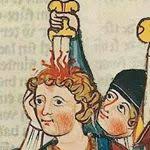|
Halloween Jack posted:Also, maybe I'm crazy, but are some of the % chances to do Thief Stuff another one of those things where they would write "2-8 damage" instead of 2d4 damage? Like, an 87-88% chance to Climb Walls is the same as 7-in-8 on a d8. I think the thief skills began as "1-2 on a 1D6" stuff like the special rules demihumans had for spotting secret doors, inclines, and the like.
|
|
|
|

|
| # ? Jun 6, 2024 13:31 |
|
Halloween Jack posted:Also, maybe I'm crazy, but are some of the % chances to do Thief Stuff another one of those things where they would write "2-8 damage" instead of 2d4 damage? Like, an 87-88% chance to Climb Walls is the same as 7-in-8 on a d8. Looking over my copies of the AD&D player's handbook and BECMI rules it looks like the weird percentage chances for Thief abilities as they level are actually the result of each ability increasing by a set percentage value each level, many of which aren't multiples of 5 so it leads to them having a bunch of weird percentage chances at odd levels. Also the rate at which a bunch of the abilities improve start to change as the Thief gets into higher levels - Move Silently in AD&D, for instance, starts at 15% and increases by 6% every level until they hit 5th level, when it starts increasing at 7% until they hit 7th level, when it starts increasing by 8% until 12 level when it hits 94% and gets one final boost of 5% at 13th level to bring it to 99%, where it stays for the rest of the Thief's career. It sees a similar change in the Master Rules booklet, but instead of the boost increasing at level 5, it instead decreases from 5% per level to 4%, before decreasing to 3% at 9th level, 2% at 13th and 1% at level 26. So there's a bunch of weird increases to Thief skills, but there seems to be a vague pattern all of the increases follow, which I think is why some of the results would correspond to the values of some of the other common die rolls. It's not helped by the fact that Gygax really liked to just list number ranges in place of actual dice math with early AD&D products. PeterWeller posted:I think the thief skills began as "1-2 on a 1D6" stuff like the special rules demihumans had for spotting secret doors, inclines, and the like. I think you're thinking of how the Thief ability to Hear Noise is rolled on a d6 in the original Basic sets, as opposed to all of the other Thief Abilities which are percentage roll-under. edit: Oh, and I almost forgot the weird case in AD&D where Climb Walls checkes start to increase by .1% per level after 10th (When the Thief's chances hit 99%), with the explanatory text seeming to suggest that the DM is supposed to roll an additional d10 for the decimal place. This is in contrast to the (In my opinion much more sensible) approach BECMI takes of having Thief ability chances go above 100%, with the extra percentages acting as a buffer against penalties to the check. KingKalamari fucked around with this message at 23:08 on Jan 5, 2024 |
|
|
|
I think Arneson used 2d6 range for all stats and skills with perhaps the same save/ability/skill check mechanism for each? Maybe 2d6 roll-under? So it's actually been there since the beginning. Dave Megarry's character matrix is always fun to look at. There's a theory that for example, checking for secret doors began as some kind of stat check in Arneson's game, then Megarry put it into Dungeon! but simplified it for boardgame purposes, and Gygax took it into D&D from that. Forget Gloomhaven, Dungeon! was right there the whole time.
|
|
|
|
Dragon'sfoot is 1e grogs Giant in the Playground is 3.5 grogs this site is 4e grogs 5e is the default so the fans aren't grogs... yet is there a place where 2e grogs congregate? it spawned some of the all-time favorite modules and settings, but I've never seen anyone say anything nice about the game system
|
|
|
|
semi-serious answer: the Infinity Engine games thread e: I've learned a whole bunch about 2e RAW by playing Baldur's Gate 1 and 2. there was even a relatively recent update to correct some of the things that hadn't lined up with the rules for 20 years or some poo poo and now do Empty Sandwich fucked around with this message at 20:45 on Jan 7, 2024 |
|
|
|
mellonbread posted:Dragon'sfoot is 1e grogs
|
|
|
|
Dipping my toes into OSR by trying out OSE with my group in a couple of weeks. Really digging the format of the books and especially the zine culture. I've checked out d12 Montly, Carrion Crawler and Knock. What others are good? Looking for rules, game tips etc. Adventures are cool, but I mostly got what I need there. Add to that, I'm running my game in the Eberron setting, so if anyone knows of zines or books that would mesh with that I'd be ever so grateful.
|
|
|
|
KingKalamari posted:I think you're thinking of how the Thief ability to Hear Noise is rolled on a d6 in the original Basic sets, as opposed to all of the other Thief Abilities which are percentage roll-under. Oh yeah, you're probably right. I know I've seen other Thief skills expressed that way; it must've been in an OSR game.
|
|
|
|
Kickstarter backer copies of the new printing of Worlds without Number are shipped out. he's got some extra copies here: https://sine-nomine-publishing.myshopify.com/products/worlds-without-number-offset-print
|
|
|
|
You do, in fact, gotta hand it to 'im: I like the LotFP skill system. If you're gonna have a skill system in your OSR game, it's one of the best.
|
|
|
|
I wanted my current group (5e players) to try DCC since I had played it a couple of times before and recalled it being fun. I convinced our DM to run it once. They bounced on it for unjustified and justified reasons. Unjustified reasons were them complaining it was confusing and lacked choices when they didn't even read the quick rules for their particular classes. E.g. they had to be reminded to burn Luck because they simply forgot they could even do that. Justified, possibly, reasons included a lot of rinse and repeat with searching for traps, investigation, etc in every room and hallway of the many areas in the People in the Pit adventure. For the latter, I can definitely understand. I suspect it was the particular adventure, but is this a common complaint about DCC and other OSR systems?
|
|
|
|
Generally, these old style game systems make searching take time and that incurs more chances for wandering monsters. I recently ran the ancient d&d board game Dragon Quest, and that was a major dynamic, you CAN search every room but that's more rolls for random encounters. Instead, it would be better if you listened to the description of the room and tried to do clever things to avoid a potential trap, because that doesn't take time or require a dice roll.
|
|
|
|
"The spike hits you for seven damage" "What?" "The spike hits you for seven dama-" "I said I was searching every corridor for traps after I fell in that pit!" "No you didn't." "Yes I did!" "Nuh uh!" "Yeah huh!" In every RPG in every genre since the dawn of the hobby. It's the reason I don't really put traps in the dungeon anymore, except obvious ones where the challenge is avoiding/disabling rather than detecting them.
|
|
|
|
I have always been a bit confused as to what that kind of heavily trapped dungeon in game systems where you often can't even save against the damage are for. Like every single corridor and room is a Wish spell interpreted by a genie who wants to kill you and the only tool you have is checking every pixel of conceptual space like a Sierra adventure game puzzle you're totally stumped on. If it's assumed you have to be checking for traps like you're in a minefield, then why even have to keep mentioning it? And if it's already assumed, what's the point of it not being some kind of passive perception background roll? And if it's not that, do you really want the game to be 3.5 hours of annoyed players poking every single brick with a pole only to still get melted with acid because aha they didn't ALSO put a marble in the ground in THIS room to see that it was sloped a few degrees, clearly indicating that blah blah blah. Good game, guys. You've progressed 80 feet. See you next week? It just seems like another old game design thing that didn't model what they wanted it to model because game design just lacked the vocabulary to do so at that point.
|
|
|
|
I usually treat the finding of traps as automatic, assuming the PCs are moving at a normal cautious speed. Then use the Detect Traps roll as more of an “understand how the trap works” roll to find out the exact risks involved. Then they can use resources or cleverness to overcome it, or roll to Disable Traps if they can’t think of anything.
|
|
|
|
I like the idea of either telling the players there are no traps or having some kind of passive detection that only comes up when there's an actual trap. Ultimately, it sounds like it's something the DM should recognize as slowing down the game and making it boring. I like our DM because he's thorough and has the time and desire to do prep work for the games and on roll20, but I think he needs to be better at engaging everyone with adventures sometimes. It's a tough job and I don't envy him for it at all. I suppose I should be more honest with feedback as well.
|
|
|
|
The way I do it is checking for traps happens automatically, but if I describe a room (with a trap) and the players investigate the trap, they find it. Their investigation has to rise to the level of showing some correct suspicion, though. So like if there's a rug on the floor and you go move the rug, yeah there was a pit. So you've got an automatic roll or passive check that is happening regardless and it kind of both your default and your final line of defense, and the you've got correctly guessing what the trap is and that automatically works. If the players tear every room apart like a Sierra adventure game I don't actually know what I'd do, my traps are more of a once a dungeon thing, I don't run dungeons with six traps across a dozen rooms. I guess I'd say that, if the players start doing everything then there's no actual guessing element and we have to instead move everything back to relying on the numbers but I'll give them advantage and make their progress slow and noisy? I'd suggest that and see if they like it, rulings not rules I guess?
|
|
|
|
Jack B Nimble posted:Generally, these old style game systems make searching take time and that incurs more chances for wandering monsters. This actually reminds me of something I've run into and have wanted to discuss in the thread for a while now but keep forgetting - I've been having a fair bit of success running games in WWN for the past year, to the point that its become my system of choice as a DM, but oddly enough the one rule from the Old School style of play that's become a minor friction point in multiple groups is wandering monsters? Basically in every group I've had there always seems to be one player who overanalyzes a random encounter and feels like they need to figure out where the monster came from, or puts far too much effort into trying to "outsmart" the encounter mechanics by barricading doors or setting up surveillance systems to prevent wandering encounters from happening. Pretty much every time I've had to jump out of the fiction of the game to tell the player in question that's just part of how the game works. In my experience it tends to be a sticking point for players who view the game more as an engineering puzzle that they can pre-solve and/or one who are very entrenched in the idea of game system as simulation of real life rather than as abstraction. I just want to know if there's a good way to convey to these players that wandering monster encounters are just a part of how the game works and not to think too hard about the specific logistics of it without having to pull back the curtain too far mechancially.
|
|
|
|
I know it's a boring answer, but or course you could have a session zero talk about wandering monsters, and what they're there for, and do the players think that sounds like what they want to play blah blah etc. As for having to justify them, I mean, no answer will satisfy a player that starts out thinking it's dumb. These orcs must have been out of the dungeon and now they've returned, this slime normally haunts the dark pit in the abandoned section but it's drawn by the tumult of the player's effectively raiding the orc base. This bear followed the party in and it smells blood. FWIW I like my random encounters to draw from a rough pool of possibilities. Like, the encounter roll doesn't create the monsters, it just means monsters I already vaguely knew* were around have simply chosen now to have arrived. *But none of it would survive a player starting out skeptical.
|
|
|
|
It also means more than 'there is a monster, it attacks, roll initiative'. It's a new problem the players have to deal with.
|
|
|
|
KingKalamari posted:or puts far too much effort into trying to "outsmart" the encounter mechanics by barricading doors or setting up surveillance systems to prevent wandering encounters from happening. Unless you're dedicated to every wandering monster being a combat encounter, I think you should let this one go.
|
|
|
|
Yeah, like a patrol of orcs comes by, tries the blocked door, talks about something in orcish (which might reveal useful information) and either tries to break in or moves on. That's a fun encounter with lots of possible moving parts and decision points for the players.
|
|
|
|
Yeah, exactly. Like if every random encounter you've run has ended in a fight, then I can understand players reacting that way. But an encounter could be some big monster who's neutral towards the party just wandering by - they can engage if they want, they can creep away, it's up to them. It could be idk, a couple sprites loving around with a group of goblins. Maybe the party helps the sprites, maybe they help the goblins, maybe they hang back and make popcorn, etc... You can use encounters for atmosphere, for optional challenges, for random lucky breaks (oh neat an amulet on this skeleton).
|
|
|
|
Having interesting random encounters is really important. They also shouldn't necessarily all be bad, and there should be a window in their roll where nothing happens, and the bad ones should be choreographed enough for the players to know that danger is coming their way. Other adventuring parties, cave-ins, pockets of gas, noxious spores, swarms of rats, a thief, a random merchant, a sprite (mischievous or helpful), a chest (potentially a mimic) are all great options. I also think sometimes you should have straight up rewards in your random encounters table, things that your players should only rarely get depending on the reward (maybe if you're rolling a d100 for random encounters, on a natural 100). Move the magical sword the players were gonna find in another session or two into a random encounter, then replace the magical sword later down the line with a lesser magic item. Functionally the player gets the powerful item maybe a session earlier, but to them it feels like some miraculous, lucky situation. I've also had great success with a recurring NPC the players only find when they roll within a specific range, like some strange godlike being they keep bumping into. They grant the players small rewards at first, but then with subsequent encounters, the rewards get more powerful. The players can only encounter this being once per encounter table. On the flip side, the players also have a (small) chance of encountering a recurring villain that constantly stalks the players, something really threatening that despite dying always seems to come back. If the players manage to defeat it X number of times, it drops some awesome piece of loot that makes it worth the trouble. Finally, I really like introducing new quest lines in random encounters. In the campaign I'm running now, the players randomly encountered a powerful paladin who was escorting a prisoner. The paladin asked the players to take the prisoner to a nearby village so she could clear out a bandit camp. The catch was that no harm could come to the prisoner, as the paladin has an oath of reformation, having been a former criminal herself. But the townspeople all want this prisoner killed for burning down one of the nearby villages. Now the players are torn between protecting the prisoner from the townspeople, letting him go but dealing with the paladin, or killing him themselves. This entire quest line, and new NPC that the players have grown to like, has come entirely from a random encounter. It also has far reaching ramifications, as this NPC is tied directly to one of the main villains of the campaign. Verisimilidude fucked around with this message at 21:18 on Jan 9, 2024 |
|
|
|
sebmojo posted:It also means more than 'there is a monster, it attacks, roll initiative'. It's a new problem the players have to deal with. That I'm usually pretty on top of - I always try to do a reaction roll for wandering encounters and try to choreograph the dangerous ones beforehand. I don't really know how else to describe it since I feel like I'm fitting these encounters in as organically as I can, but I always have a player in every group who needs a big explanation as to why there's a wayward orc wandering around? It might also just be residual paranoia from one player who seemed to make it a point to be as miserable as possible every time the party ventured into a dungeon... sebmojo posted:Yeah, like a patrol of orcs comes by, tries the blocked door, talks about something in orcish (which might reveal useful information) and either tries to break in or moves on. That's a fun encounter with lots of possible moving parts and decision points for the players. Verisimilidude posted:Having interesting random encounters is really important. They also shouldn't necessarily all be bad, and there should be a window in their roll where nothing happens, and the bad ones should be choreographed enough for the players to know that danger is coming their way. These, however, does give me a new way of approaching the potentially hostile encounters, thanks!
|
|
|
|
This is something I'm really looking forward to when it's my turn to run a game for my group; random encounters that specifically aren't intended combat encounters. I want, for example, to have the party shelter in an old tower on a high hill as a nasty storm passes, roll a random encounter and find that's its, for example, 2d8+2 goblins, and describe them as visible coming up the hill, armed but not seeming to anticipate a fight. I'd love to see my gaming group approach this is as a problem, and see them do things beyond a pure set piece battle like try to negotiate with the goblins, or hide from them, or even disperse and discourage them with a nasty ambush; I'd like for the goblins to not carry a level appropriate portion of treasure, I'd even like to see "defeating" them award no XP or benefit aside beyond whatever motivation or justification the players can arrive at for their characters. I think (I hope), that if I were a player in that game I'd find it thrilling that it's not planned, there's no predetermined outcome, and the possibilities, up to and including us all being killed, is going to be up to the choices we make a bit of luck. Relatedly, my Old School Essentials rulebook set came in today, I can't wait to read it again work. The tables written into the inside covers already caught my eye.
|
|
|
|
I'm definitely partial to traps that foreshadow themselves quite a bit--less traps and more puzzles. Like, a pit trap in the middle of a non-descript hallway is pretty boring. You can maybe just treat it as an attrition thing--being in the dungeon is inherently a little dangerous and you're going to rack up some damage just by being there. That's a little unsatisfying, though, and it definitely needs to be low-stakes; taking 1d6 damage and maybe starting a fight from a bad position from falling in a pit is fine, but falling onto poisoned instakill spikes is deeply unfun. Even that's mostly just obnoxious, though. Things that are more like "there's a hole in the wall and you see something glinting at the end of it" are a lot more interesting to me. You have a concrete thing to investigate, it's not going to feel out of nowhere when it's trapped, and it's fairly open-ended in terms of how you can interact with it. I think there are some things that can skirt the line between the two types that can be fun, too. If there's a weirdly nice carpet in the middle of a dungeon hallway, maybe it's the players' faults if they don't check to see if it's covering up a pit? It needs to key off of incongruities in the room descriptions, though--a carpet hiding a pit in a dungeon where most rooms have carpets would go back to being unfair again.
|
|
|
|
Make traps that your players can use to their advantage. Put a pit in the middle of the room and let them throw people into it. Put some swinging blades and let them lure dumb monsters into them. If a trap is in the way, or is hidden, I make them damaging but not especially deadly. A trap should take away 25%-30% of the beefiest character's HP, or 50-75% of a thief's HP (whichever is lower) at most, meaning all but the absolute weakest characters should survive getting hit by them. Disabling traps is doable, but not necessary in all circumstances. Instead, I like to treat avoiding a trap as a die roll if it's especially complicated, or if the PC is under duress. A disabled trap stops working entirely, but an avoided trap becomes a hazard players need to keep in mind. Example: The floor tiles of a narrow corridor contain pressure plates that, when stepped on, cause poison arrows to shoot down the length of the corridor. If the players crawl, or lean against the wall, they can avoid these arrows. PCs that know the location of the pressure plates can navigate if they take their time, or with a DC15 Intelligence check if they're rushing. Verisimilidude fucked around with this message at 23:02 on Jan 9, 2024 |
|
|
|
medchem posted:E.g. they had to be reminded to burn Luck because they simply forgot they could even do that. Unless you're a thief, halfling or its the big finale of a oneshot you don't ever want to be burning luck. It probably shouldn't even be an option.
|
|
|
|
Can't remember where I first read/heard it, but a good rule of thumb is to make deadly traps found to everyone without a roll (so the test is disabling/evading it) while traps that are just a nuisance can be more hidden.
|
|
|
|
I personally do try to conceive of the ecosystem and relationships of the monsters in an area or dungeon from first principles and proceed from there, as in yeah, all the monsters they could encounter or that could jump at them from a wandering monster table have a justifiable reason to be there, they have a desired outcome for their activities that makes sense to them, they have responses to conditions and stimuli that makes sense for their intelligence/experience/culture, and they behave as if they're alive and would generally wish to remain so (unless they're mindless undead or something similarly lacking in self regard). They know where they came from and where they'll return to, and things regarding them continue to happen outside of the PC's bubble of awareness as time progresses. But I will also cop to that compulsion probably owing to my specific neuroses that demand I over prepare, and not due to some proscriptive "extra special good DM" instincts. I will say it doesn't hurt to have a sketch of an idea as to why a monster lives where it lives and does what it does, but a lot of that can probably be whipped up on the fly. If they're game for it, you could even ask the PCs and run with their answer as you flesh the area out together. There's also the easy response of making it a known quantity that this whole area is crawling with undead because of a necromancer's curse, or infested with goblins because of the power vacuum left by two kingdoms engaging in slash and burn warfare so there's tons of empty space and scrap weapons and armor for the rapidly reproducing horde to appropriate. Then that automatically fills in the question of "why are these creatures here" with an easy "because you already knew the area is lousy with them and their dens are everywhere."
|
|
|
|
Sad news today. Jennell Jaquays passed away this morning.
|
|
|
|
SkeletonHero posted:Sad news today. Jennell Jaquays passed away this morning. Oh drat I was just reading Caverns and Dark Tower the other week
|
|
|
|
SlimGoodbody posted:I personally do try to conceive of the ecosystem and relationships of the monsters in an area or dungeon from first principles and proceed from there, as in yeah, all the monsters they could encounter or that could jump at them from a wandering monster table have a justifiable reason to be there, they have a desired outcome for their activities that makes sense to them, they have responses to conditions and stimuli that makes sense for their intelligence/experience/culture, and they behave as if they're alive and would generally wish to remain so (unless they're mindless undead or something similarly lacking in self regard). They know where they came from and where they'll return to, and things regarding them continue to happen outside of the PC's bubble of awareness as time progresses. l will say I personally don't perform well with completely random encounters. Sometimes they work out, but other times I'll flounder. I struggled running Scum & Villainy because that game is all about deliberately not prepping and letting the story flow directly from the player's actions. So instead what I do is I roll random encounters ahead of time, and sketch out when they'll appear, modifying the encounters to make them more interesting. For example, in the campaign I'm running we have 2 random encounters per day (one during the day and another at night). I knew it would take my players about 6 days to go from point A to B, so I pre-rolled about 14 random encounters and set them up linearly with notes, making sure not to stack too many combats in a row. It rolled out like the following: Day 1: Floating debris, shattered wooden planks of a cargo ship. Pirates are nearby (players can attempt to avoid, but failure means pirate attack) Night 1: Merfolk traders (14), no magic items Day 2: Nereid (offers cryptic premonitions) Night 2: Kraken Society Cultists (5) Day 3: Sea Elves (14) Night 3: Passing warship (friendly), from Gundarlun Day 4: Trolls (2) Night 4: Merchants (16), transporting 4 boxes of scrimshaw worth 50gp each etc. In this way the players had the experience of running through a randomly generated series of events, but they were tailored to be a bit more fluid and enjoyable. Dice can sometimes tell fun stories, but dice can just as easily tell bad stories. I think we got through 3 full days and ended on day 4, when the trolls attacked. Meaning we started with action (avoiding an enemy pirate ship) which lead to a reward (fighting the pirates and plundering their stolen loot), then a bunch of RP, then we ended the session with the promise of action as on the morning of Day 4 trolls board and attack the ship, which we saved for the start of the next session. I won't do too much prep for each roll, but I'll set up the "why" and "how" and what the goal of each thing is. For most situations it's easy. The merchants want to reach Neverwinter safely to sell their loot at market, the warship is patrolling to attack pirates. Some however inspire more thought, such as the nereid (I think initially intended to be a fight, but I turned her into a mermaid who dropped cryptic clues about where the story would lead), and the kraken cultists, who are secretly aligned with one of the other party members. Verisimilidude fucked around with this message at 17:21 on Jan 10, 2024 |
|
|
|
Wandering monsters make more sense in a megadungeon type environment, where there is kind of a large between zone of hallways and empty spaces, like in this picture of the EPT Jakallan underworld that blows my mind: When you have a large complex in-between space, that's more space for encounters to arise from, or melt away into. You also get this for free in hexcrawls and point crawls and what-have-you crawls. The place you DON'T get it is kind of the standard modern D&D dungeon map that has like 8 oddly large rooms with short corridors between them. In a lair-size dungeon like that, it's probably okay just to not have wandering monsters because the exploration game isn't really kicking in anyway.
|
|
|
|
Sax Solo posted:Wandering monsters make more sense in a megadungeon type environment, where there is kind of a large between zone of hallways and empty spaces, like in this picture of the EPT Jakallan underworld that blows my mind: Yeah, this exactly. I don't think there's any problem rolling an encounter up ahead of time either, that's just going above and beyond and being a good GM. There's certainly no great virtue in spending less time on an encounter in service of being faithful to the idea of it being completely random, as opposed to letting the dice guide you and coming up with something interesting ahead of time to pull out when appropriate.
|
|
|
|
In a smaller dungeon I think wandering monsters still serve a purpose in that they give an obvious bit of risk/reward to searching things thoroughly or other large time investments. But you can easily substitute something else for that. You could just take on of the existing encounters and have that wander if appropriate, or you could have some kind of environmental element that creates time pressure. Rising water, no interior light sources, that kind of thing.
|
|
|
|
mellonbread posted:I decided to actually do this. The actual game has got me thinking about this post again Sax Solo posted:apparently Gygax allowed Rob Kuntz to explore solo, without any special vision, by just popping open the hooded lantern now and then and avoiding most encounters (and not having map). Wandering monsters are the primary threat in Esoteric Enterprises, since the dungeon generator does not produce a lot of keyed monsters. Each dungeon biome has its own monster spawner that generates thematically fitting encounters. The undercity is filled with flooded tunnels and narrow squeezes that are impassable to normal humans but trivial for creatures to traverse, allowing the beasts to plausibly move between areas. The monster tables regularly produce encounters that would instagib the players in a straight fight, but the game's truncated reaction roll system means players with bare minimum charisma are unlikely to get an instant hostile response. I have also been using a variant of my pursuit rules adjusted for EE's Lamentations-based D6 roll under skill system, allowing the players to sacrifice carried items for a speedy escape. I might have erred too far on the side of letting them escape without fighting, but my premise for this game is they are maintenance workers rather than hardened criminals - fighting is extremely dangerous and not part of the job description.
|
|
|
|
For any BFRPG fans, I have released the 2.0 version of my DNDBeyond-like character creator this weekend. It features lots of visual upgrades, abilities to edit characters, and artwork: https://codex.quest You can:
|
|
|
|

|
| # ? Jun 6, 2024 13:31 |
|
Paranoia has aspects of that.
|
|
|




































.jpg)
